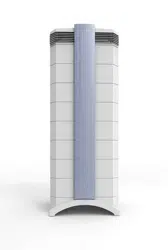Loading ...
Loading ...
Loading ...

4
Chapter 1 – Air Cleaning Systems and Indoor Air Quality
Chapter 1 – Air Cleaning Systems and Indoor Air Quality
State-of-the-art ltration technology
Your IQAir advanced air cleaning system has been developed especially for the control of specic gaseous
components. Thanks to advanced gas cartridge (GC) lter technology, each model of the IQAir GC Series has been
optimized for the control of specic gaseous pollutant groups. The following model congurations are available:
• IQAir GC VOC for the control of volatile organic compounds
• IQAir GC MultiGas for the control of volatile organic compounds and many inorganic compounds
• IQAir GC Chemisorber for the control of many inorganic compounds and some organic compounds
• IQAir GC AM for the control of ammonia and amines
1.1 Improving Indoor Air Quality
Air cleaning can play an important role when it comes to improving indoor air quality. However, it should be noted
that air cleaning should be used in conjunction with pollution source control and ventilation, wherever possible.
Strategy to improve indoor air quality
To tackle any indoor air quality problem, keep the following three-step strategy in mind:
1. Eliminate or reduce the air pollution source as much as possible. Source control is by far the most effective way to
improve indoor air quality, since it sets out to deal with air pollution at the point of origin.
2. Ensure that sufcient fresh air is entering the room from outside. Air cleaners are not a substitution for sufcient
ventilation. They are not able to reverse the conversion of oxygen (O
2
) into carbon dioxide (CO
2
), caused by
breathing and combustion processes.
3. Ensure the IQAir system can clean enough air to cope with your room size. The actual hourly air volume cleaned
by the system should be at least double the air volume of your room. If the rate at which pollutants enter the room
air is high or the indoor air quality requirements are stringent, the hourly air delivery of the system needs to
exceed the room air volume several times. To achieve that level of air turnover, it may be necessary to employ
more than one IQAir system, or consider the larger GCX model (refer to section 4.3.2).
Air Cleaning Results
Although air cleaners may be advertised and sold to be suitable for use in specic indoor environments and to deal
with specic indoor air quality problems, the manufacturer and distributors make no claim as to the specic air
cleaning results that are achieved under the user’s individual operating conditions. The air quality improvements
that can be realized with the IQAir system (as with any air cleaner) in indoor environments depends to a signicant
degree on circumstantial factors, which are out of the control of the manufacturer or distributors. Important factors
which will inuence the air quality improvements that can be achieved in an indoor environment with an air cleaner
include:
• Type of air pollutants present and their filtration efficiency
• Intensity of the pollutant source(s)
• Pollutant concentration
• Size of the indoor environment (room size)
• Operating speed of the air cleaner
• Number of air cleaners placed in the indoor environment
• Saturation state of the lters in the air cleaner
Consult a qualied specialist to determine an effective and comprehensive indoor air quality strategy.
Caution: Intense concentration of pollutants may cause filters/cartridges to saturate or expire sooner than indicated
by the control panel.
Loading ...
